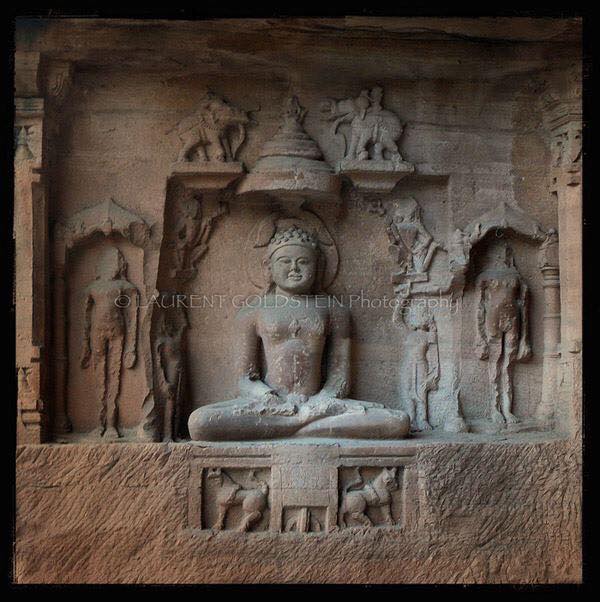Update
पारस रे तेरी कठिन ड़गरिया.. किस विध में तोहे पाऊँ रे संवलिया.. exclusive tofay photograph 😍📚 इस वारी वंदना करके मन तन वच सब भक्ति में डूबा हैं ख़ूब 🤔😊😊
 Source: © Facebook
Source: © Facebook
Update
This picture was shot at sunset under Gwalior Fort where 24 Jain thirthankara (saint) rockcut statues are overlooking the city of the central Indian state of Madhya Pradesh.
Arihant (Jain Prakrit: अरिहन्त arihant, Sanskrit: अर्हत árhat "vanquisher of enemies") in Jainism is a step before becoming siddha. Arihantas destroyed all gathi karma and still living until they reach the Siddha status. The Ṇamōkāra mantra begins, Ṇamō arihantāṇaṁ "I praise the Arihantas".
Arihanta is not a synonym for Tirthankara, which refers specifically to certain arihants who have certain karmas that enable them to become spiritual leaders.
Jains believe that the arihant has defeated anger, ego, deception, and greed - universal inner enemies or kashayas responsible for the perpetuation of Self-ignorance. When that happens, the person has destroyed the four ghati karmas, namely Gyanavarniya (knowledge blocking) Karma, Darshanavarniya (perception blocking) Karma, Mohniya (passion causing) Karma and Antaraya "obstacle-causing" karma. Thus the arihant obtains:
Kevala_Gyana, perfect knowledge due to the destruction of all Gyanavarniya Karmas,
Kevaldarshan, perfect perception due to the destruction of all Darshanavarniya Karmas,
becomes passionless due to the destruction of all Mohniya Karmas,
gains infinite power due to the destruction of all Antaraya Karmas.
Complete knowledge and perception means they know and see everything everywhere that is happening now, that has happened in the past, and that will happen in the future.
Tirthankaras are special arihants because they revitalize the sangha, the four-fold order consisting of male saints (sādhus), female saints (sādhvis), male householders (Śrāvakas) and female householders (Śrāvikas)..
Jains believe that during every half-cycle, twenty-four persons rise to the level of Tirthankara. The first Tirthankara of the current time cycle was R̥ṣabhadēva, and the twenty-fourth and last Tirthankara was Mahavira, who lived from 599 BCE or 527 BCE.
An arihant is also called a jina "conqueror". At the time of nirvana, the arihant sheds off the remaining four aghati karmas:
Nam (physical structure forming) Karma
Gotra (status forming) Karma,
Vedniya (pain and pleasure causing) Karma,
Ayushya (life span determining) Karma.
These four karmas do not affect the true nature of the soul and are therefore they are called aghati karmas. After attaining salvation, these arihants are called siddhas.
In the Ṇamōkāra mantra, Jains pray to the arihants first and then to the siddhas even though the latter are perfected souls who have destroyed all karmas and are considered to be at a higher spiritual stage than arihants. Since siddhas have attained ultimate liberation, they are inaccessible, but arihants are still human beings and can offer spiritual guidance.
 Source: © Facebook
Source: © Facebook
News in Hindi
Live... Shikhar G.. ✌️✌️😄😄
 Source: © Facebook
Source: © Facebook
